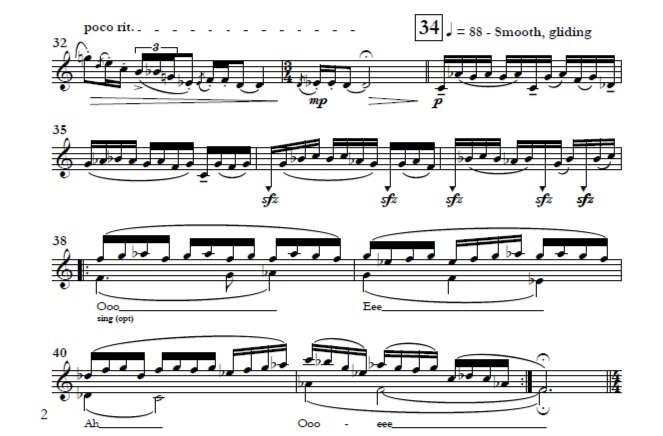Project 12: Hop To It!
We’ve had several misty mornings here in Portland, but this low-sitting fog over the river last week was such a beautiful, mysterious view!
A wonderful part of composing is that sometimes things like watching penguin videos becomes relevant to your work process! For the last week, I’ve had the pleasure of working on a solo flute work for Dr. Elizabeth Robinson about Rockhopper penguins. While I’ve always been comfortable writing for flute, for this particular work I hoped to push myself to meaningfully use a few new-to-me extended techniques!
Wrap-Up: Hoppy Feet
Rockhopper penguins tend to live in climates that are a bit warmer than the North and South poles, and as such the terrain is rather rocky rather than icy. This means that, unlike their cousins in the Arctic and Antarctic, they cannot slide around on their bellies to get around on land—instead hopping on the rocks. While not particularly graceful-looking, their home on the rockier terrain also limits the amount of natural predators, a majority of which are in the water. Despite their strange appearance and quirky land-movements, however, they are quite powerful and graceful swimmers! To capture both the peculiarity and finesse of these interesting creatures, I ended using quite a wide range of techniques and colors.
The opening bars present the main thematic material for the piece. Comprised of two repeated notes, decorated with grace notes in the opposite direction, the gesture rises up to a quick turn-around. This then plops suddenly downward with a tongue pizzicato (a dry, percussive sound produced with a hard articulation, rather than with air). The turnaround gesture appears once more, now in a lower register, before the line ricochets upward in a flutter-tongue run. In measure 5, we get a foot stomp and alternating notes of ordinario and flutter tongue before settling down to the first sustain of the piece. Measure 7 (another gesture that appears throughout the work) extends the feeling of sustain briefly before dropping us back to the quirky grace notes of the opening.
In measure 34, we get an extended section of legato playing—meant to depict the grace and smoothness of Rockhopper swimming (the lower notes here almost give the illusion of penguins “dropping in" to the water). Measure 38 introduces sing-and-play on various syllables—which create subtle changes in the flute’s timbre (the different vowels activate different overtones). For flutists who are uncomfortable singing and playing simultaneously, I’ve kept the gesture optional, and made sure the section works both with and without the voice. I also employ speak-and-play towards the end of the work (m 78), the syllables chosen both for their percussiveness and their ability to be executed quickly.
At measure 43, we get the return of transition material (meant to depict the penguins trying to get back on the rocks from the ocean, struggling against the waves). In this case, the ocean prevails and the penguin is sucked back out to sea. This section employs a series of tremolos and fast leaps (acting as sort of quasi-tremolos) that ultimately float downwards. The lowest notes of the section get thinned out here through the use of breathy tone, preparing the listener’s ear for the colder, more abrasive color of the harmonic glisses that end the section (a technique executed by controlled overblowing).
The aforementioned speak-and-play gesture kicks off the final section, which mixes the gestures of the entire piece in quick succession—grace notes, flutter tongue, foot stomps, tremolos, speak-and-play. A dramatic final push is created with the simultaneous use of flutter tongue technique and a trill, which helps catapult the final runs upward. The last two bars bring back the grace-note gesture from the opening, now with each main note approached from below - catapulting the gesture upward to the final high C. The piece ends with a brief sustain (approached with a grace-note, of course) and a final punch from a tongue pizz.
“Break” Week!
When I planned out this project, I gave myself a break during the week of Thanksgiving so I could rest, get in touch with the next round of commissioners, and plan (and continue working on Week 6, which is well under way, now)! I also have a few larger projects that I’ve been working on, and hope to focus in on more this week.
I’m wrapping up a work for 3-octaves of gongs and various percussion for the group, Thought Form Collective (commissioned by composer and musician, Drew Morris). The piece-in-progress is called GO(i)NG ME(n)TAL. This work already has two out of three movements done (Iron(y), which explores metric modulations, and Lead Astray, which explores pitch relationships), and I’m very exciting to be in the final stages!
I’m also working on an exciting commission for oboe and brass quintet inspired by four female Olympians (Dominique Dawes, gymnast; Gertrude Ederle, swimmer; Michelle Kwan, figure skater; and Wilma Rudolph, sprinter). The commissioner, oboist Rebecca Keller, will be premiering the work as part of her doctoral recital next year. Having already written the Michelle Kwan movement (and crying as I watch her skate!), I’m excited to learn more about these truly amazing athletes, advocates, teachers, and leaders.
I plan to write more about these larger projects in the coming months, so check back again soon for more updates! I hope all of you have a wonderful, safe, and delicious Thanksgiving, and get time to see and/or talk to the people you love most this week.
Happy music-making!







